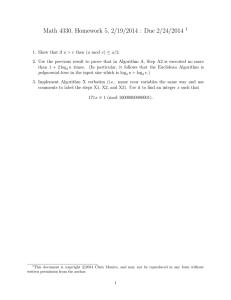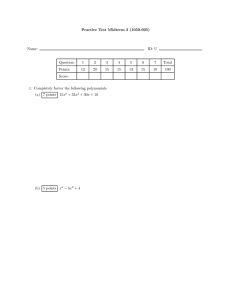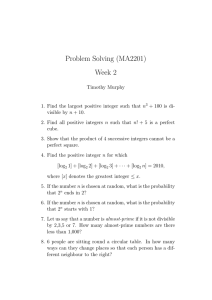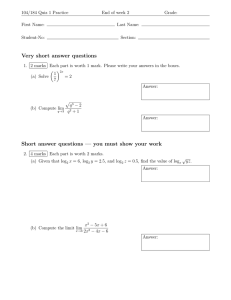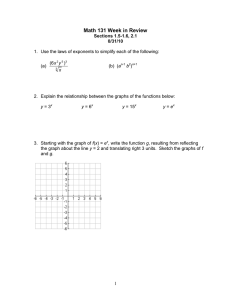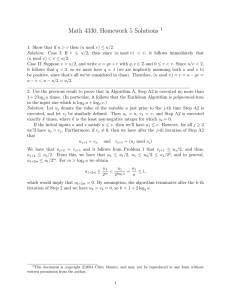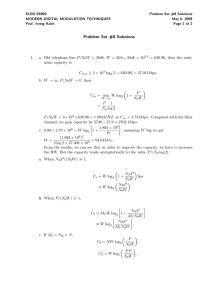Variable-length compression allowing errors Please share
advertisement
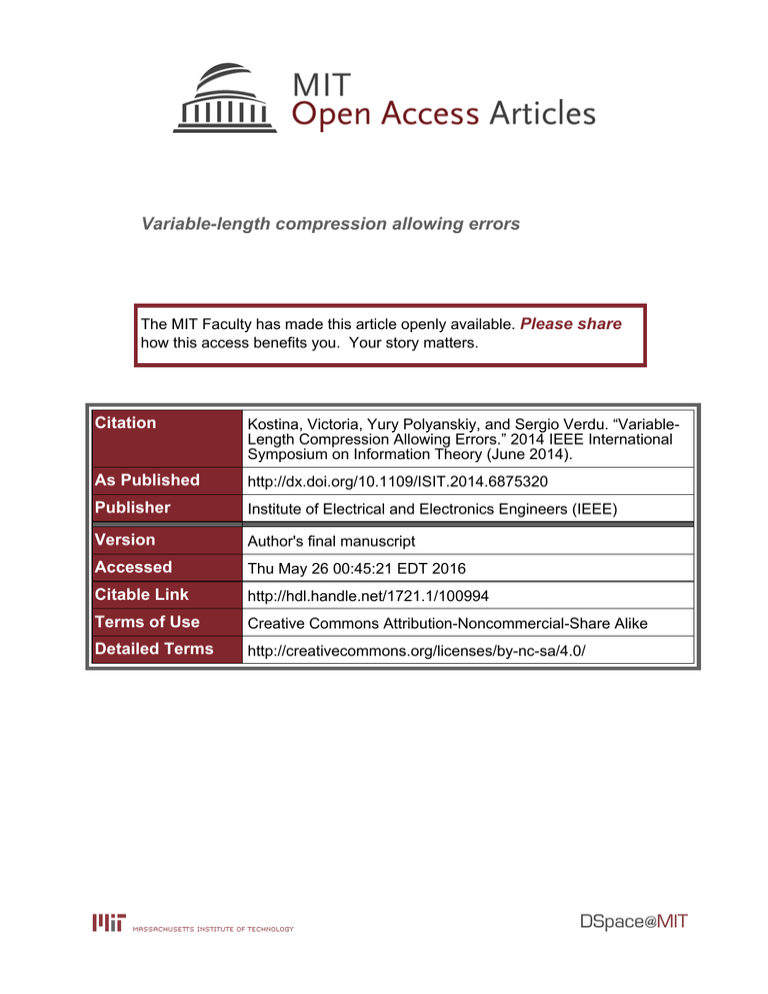
Variable-length compression allowing errors
The MIT Faculty has made this article openly available. Please share
how this access benefits you. Your story matters.
Citation
Kostina, Victoria, Yury Polyanskiy, and Sergio Verdu. “VariableLength Compression Allowing Errors.” 2014 IEEE International
Symposium on Information Theory (June 2014).
As Published
http://dx.doi.org/10.1109/ISIT.2014.6875320
Publisher
Institute of Electrical and Electronics Engineers (IEEE)
Version
Author's final manuscript
Accessed
Thu May 26 00:45:21 EDT 2016
Citable Link
http://hdl.handle.net/1721.1/100994
Terms of Use
Creative Commons Attribution-Noncommercial-Share Alike
Detailed Terms
http://creativecommons.org/licenses/by-nc-sa/4.0/
Variable-length compression allowing errors
Victoria Kostina
Yury Polyanskiy
Sergio Verdú
Princeton University
vkostina@princeton.edu
MIT
yp@mit.edu
Princeton University
verdu@princeton.edu
Abstract—This paper studies the fundamental limits of the
minimum average length of variable-length compression when a
nonzero error probability ! is tolerated. We give non-asymptotic
bounds on the minimum average length in terms of Erokhin’s
rate-distortion function and we use those bounds to obtain a
Gaussian approximation on the speed of approach to the limit
which is quite accurate for all but small blocklengths:
!
kV (S) − (Q−12(!))2
e
(1 − !)kH(S) −
2π
where Q−1 (·) is the functional inverse of the Q-function and
V (S) is the source dispersion. A nonzero error probability thus
not only reduces the asymptotically achievable rate by a factor of
1−!, but also this asymptotic limit is approached from below, i.e.
a larger source dispersion and shorter blocklengths are beneficial.
Further, we show that variable-length lossy compression under
excess distortion constraint also exhibits similar properties.
I. I NTRODUCTION
AND SUMMARY OF RESULTS
Definition 1 ((L, ") code). A variable length (L, ") code for
source S defined on a finite or countably infinite alphabet M
is a pair of possibly random transformations PW |S : M "→
!
!
{0, 1} and PŜ|W : {0, 1} "→ M such that1
!
"
P S $= Ŝ ≤ "
(1)
(2)
The corresponding fundamental limit is
L!S (") ! inf {L : ∃ an (L, ") code}
(3)
Lifting the prefix condition in variable-length coding is
discussed in [1], [2]. In particular, in the zero-error case we
have [3], [4]
H(S) − log2 (H(S) + 1) − log2 e ≤ L!S (0)
(4)
≤ H(S) ,
(5)
while [1] shows that in the finite alphabet i.i.d. case (with a
non-lattice distribution PS , otherwise o(1) becomes O(1))
L!S k (0) = k H(S) −
1
log2 (8πeV (S)k) + o(1)
2
ıS (S) = log2
(6)
This work was supported in part by the Center for Science of Information
(CSoI), an NSF Science and Technology Center, under Grant CCF-0939370.
1 Note that L need not be an integer.
1
.
PS (S)
(7)
Under the rubric of “weak variable-length source coding,”
T. S. Han [5], [6, Section 1.8] considers the asymptotic fixedto-variable (M = S k ) almost-lossless version of the foregoing
setup with vanishing error probability and prefix encoders.
Among other results, Han showed that the minimum average
length LS k (") of prefix-free encoding of a stationary ergodic
source with entropy rate H behaves as
lim lim
Let S be a discrete random variable to be compressed into
a variable-length binary string. We denote the set of all binary
!
strings (including the empty string) by {0, 1} and the length
!
of a string a ∈ {0, 1} by !(a). The codes considered in this
paper fall under the following paradigm.
E [!(W )] ≤ L
where V (S) is the varentropy of PS , namely the variance of
the information
"→0 k→∞
1
L k (") = H.
k S
(8)
Koga and Yamamoto [7] treated variable-length prefix codes
with non-vanishing error probability and showed that for finite
alphabet i.i.d. sources with distribution PS ,
lim
k→∞
1
L k (") = (1 − ")H(S).
k S
(9)
The benefit of variable length vs. fixed length in the case of
given " is clear from (9): indeed, the latter satisfies a strong
converse and therefore any rate below the entropy is fatal.
Allowing both nonzero error and variable-length coding is
interesting not only conceptually but on account on several
important generalizations. For example, the variable-length
counterpart of Slepian-Wolf coding considered e.g. in [8] is
particularly relevant in universal settings, and has a radically
different (and practically uninteresting) zero-error version. Another substantive important generalization where nonzero error
is inevitable is variable-length joint source-channel coding
without or with feedback. For the latter, Polyanskiy et al. [9]
showed that allowing a nonzero error probability boosts the
"-capacity of the channel, while matching the transmission
length to channel conditions accelerates the rate of approach
to that asymptotic limit. The use of nonzero error compressors
is also of interest in hashing [10].
The purpose of this paper is to give non-asymptotic bounds
on the fundamental limit (3), and to apply those bounds to
analyze the speed of approach to the limit in (9), which also
holds without the prefix condition. The key quantity in the
non-asymptotic bounds is Erokhin’s function [11]:
#
H(S, ") =
=
M
#
min
PZ|S : P[S$=Z]≤"
PS (m) log2
m=1
− (1 − ") log2
I(S; Z)
(10)
1
PS (m)
1
1
− (M − 1)η log2
1−"
η
[12] (pointwise convergence) and in [13], [14] (convergence in
mean). For fixed-length lossy compression, finite-blocklength
bounds were shown in [15], and the asymptotic expansion
for a stationary memoryless source in [15] (see also [16] for
the finite-alphabet case). Our main result in that case is that
(16) generalizes simply by replacing H(S) and V (S) by the
corresponding rate-distortion and rate-dispersion functions.
(11)
II. N ON - ASYMPTOTIC BOUNDS
with the integer M and η > 0 determined by " through
M
#
A. Optimal code
PS (m) = 1 − " + (M − 1)η
(12)
m=1
In particular, H(S, 0) = H(S), and if S is equiprobable on an
alphabet of M letters, then
H(S, ") = log2 M − " log2 (M − 1) − h(") ,
where h(x) = x log2 x1 +(1−x) log2
function.
Our non-asymptotic bounds are:
1
1−x
(13)
is the binary entropy
Theorem 1. If 0 ≤ " < 1 − PS (1), then the minimum
achievable average length satisfies
H(S, ") − log2 (H(S, ") + 1) − log2 e
≤ L!S (")
e
≤ H(S, ") + " log2 (H(S) + ") + " log2 + 2 h(").
"
If " > 1 − PS (1), then L!S (") = 0.
(14)
(15)
Note that we recover (4) and (5) by particularizing Theorem
1 to " = 0.
For memoryless sources we show that the speed of approach
in the limit in (9) is given by the following result.
Theorem 2. Assume that:
• PS k = PS × . . . × PS .
$
%
3
• E |ıS (S)|
< ∞.
For any 0 ≤ " ≤ 1 and k → ∞ we have
&
'
L!S k (")
kV (S) − (Q−1 (!))2
2
+ θ(k)
= (1 − ")kH(S) −
e
k
2π
H(S , ")
(16)
where Q−1 is the inverse of the complementary standard
Gaussian cdf. The remainder term in (16) satisfies
− log2 k + O (1) ≤ θ(k) ≤ O (1) .
(17)
Therefore, not only " > 0 allows for a (1 − ") reduction in
asymptotic rate (as found in [7]), but larger source dispersion
is beneficial. This curious property is further discussed in
Section III-A.
We also generalize the setting to allow a general distortion
measure in lieu of the Hamming distortion in (1). More
precisely, we replace (1) by the excess probability constraint
P [d (S, Z) > d] ≤ ". In this setting, refined asymptotics of
minimum achievable lengths of variable-length lossy prefix
codes almost surely operating at distortion d was studied in
In the zero-error case the optimum variable-length compressor without prefix constraints fS! is known explicitly [3],
[17]2: a deterministic mapping that assigns the elements in
M (labeled without loss of generality as the positive integers)
ordered in decreasing probabilities to {0, 1}! ordered lexicographically. The decoder is just the inverse of this injective
mapping. This code is optimal in the strong stochastic sense
that the cumulative distribution function of the length of any
other code cannot lie above that achieved with fS! . The length
function of the optimum code is [3]:
!(fS! (m)) = *log2 m+.
(18)
In order to generalize this code to the nonzero-error setting, we
take advantage of the fact that in our setting error detection
is not required at the decoder. This allows us to retain the
same decoder as in the zero-error case. As far as the encoder
is concerned, to save on length on a given set of realizations
which we are willing to fail to recover correctly, it is optimal
to assign them all to ∅. Moreover, since we have the freedom
to choose the set that we want to recover correctly (subject
to a constraint on its probability ≥ 1 − ") it is optimal
to include all the most likely realizations (whose encodings
according to fS! are shortest). If we are fortunate enough that
(M
" is such that m=1 PS (m) = 1 − " for some M , then the
code f(m) = fS! (m), if m = 1, . . . , M and f(m) = ∅, if
m > M is optimal. To describe an optimum construction
that holds without the foregoing (
fortuitous choice of ", let
M
M be the minimum M such that m=1 PS (m) ≥ 1 − ", let
η = *log2 M +, and let f(m) = fS! (m), if *log2 m+ < η and
f(m) = ∅, if *log2 m+ > η, and assign the outcomes with
*log2 m+ = η to ∅ with probability α and to the lossless
encoding fS! (m) with probability 1 − α, which is chosen so
that3
#
#
"=α
PS (m) +
PS (m)
(19)
m∈M:
m∈M:
'log2 m(=η
!
'log2 m(>η
= E [ε (S)]
2 The
(20)
construction in [17] omits the empty string.
does not matter exactly how the encoder implements randomization as
long as conditioned on !log2 S" = η, the probability that S is mapped to ∅
is α. In the deterministic code with the fortuitous choice of # described above,
α is the ratio of the probabilities of the sets {m ∈ M : m > M, !log2 m" =
η} to {m ∈ M : !log2 m" = η}.
3 It
where
!
0 !(fS (m)) < η
!
!
ε (m) = α !(fS (m)) = η
1 !(fS! (m)) > η
mutual information between S and Ŝ:
(21)
We have shown that the output of the optimal encoder has
structure
fS! (m) -!(fS! (m))." > 0
W (m) =
(22)
∅
otherwise
where the "-cutoff random transformation acting on a realvalued random variable X is defined as
X X <η
η X = η (w. p. 1 − α)
-X." !
(23)
0 X = η (w. p. α)
0 otherwise
where η ∈ R and α ∈ [0, 1) are uniquely determined from
P [X > η] + α P [X = η] = "
(24)
We have also shown that the minimum average length is given
by
L!S (")
=
=
=
E [-!(fS! (S))." ]
L!S (0) −
max
E [ε(S)!(fS! (S))]
ε(·):E [ε(S)]≤"
L!S (0) − E [ε! (S)!(fS! (S))]
(25)
(26)
(27)
where the optimization is over ε : Z+ "→ [0, 1], and the optimal
error profile ε! (·) that achieves (26) is given by (21).
An immediate consequence is that in the region of large
error probability " > 1 − PS (1), M = 1, all outcomes are
mapped to ∅, and therefore, L!S (") = 0. At the other extreme,
if " = 0, then M = |M| and [2]
L!S (0) = E[!(fS! (S))] =
∞
#
P[S ≥ 2i ]
(28)
i=1
B. Achievability bound
In principle, it may seem surprising that L!S (") is connected
to H(S, ") in the way dictated by Theorem 1, which implies
that whenever the unnormalized quantity H(S, ") is large it
must be close to the minimum average length. After all,
the objectives of minimizing the input/output dependence
and minimizing the description length of Ŝ appear to be
disparate, and in fact (22) and the conditional distribution
achieving (10) are quite different: although in both cases S
and its approximation coincide on the most likely outcomes,
the number of retained outcomes is different, and to lessen
dependence, errors in the optimizing conditional in (22) do
not favor m = 1 or any particular outcome of S. To prove
(15), we let E = 1{S $= Ŝ} and proceed to lower bound the
I(S; Ŝ) = I(S; Ŝ, !(fS! (S)) − I(S; !(fS! (S))|Ŝ)
= H(S) − H(!(fS! (S))|Ŝ) − H(S|Ŝ, !(fS! (S)))
= H(S) − H(!(fS! (S))|Ŝ, E)
− I(E; !(fS! (S))|Ŝ) − H(S|Ŝ, !(fS! (S))
≥ L!S (") + H(S) − L!S (0) − " log2 (H(S) + ")
− " log2
e
− 2 h(")
"
(29)
(30)
(31)
(32)
where (32) follows from (E; !(fS! (S))|Ŝ) ≤ h(") and the
following chains (33)-(35) and (37)-(41).
H(S|Ŝ, !(fS! (S)))
≤ E [ε! (!(fS! (S)))!(fS! (S))] + E [h(ε! (!(fS! (S)))]
(33)
= L!S (0) − L!S (") + E [h(ε! (!(fS! (S)))]
≤ L!S (0) − L!S (") + h(")
(34)
(35)
where (34) follows from (25); (35) follows from (20) and
the concavity of h(·); and (33) is by Fano’s inequality: since
conditioned on !(fS! (S)) = i, S can have at most 2i values:
H(S|Ŝ, !(fS! (S)) = i) ≤ i ε! (i) + h(ε! (i))
(36)
Consider next the second quantity in (31)
1
H(!(fS! (S))|Ŝ, E)
"
≤ H(!(fS! (S))|Ŝ, E = 1)
≤
H(!(fS! (S))|S
(37)
$= Ŝ)
(38)
E [!(fS! (S))|S $=
/
E [!(fS! (S))]
≤ log2 (1 +
.
≤ log2 1 +
≤ log2
"
Ŝ]) + log2 e
+ log2 e
e
+ log2 (" + H(S)) ,
"
(39)
(40)
(41)
where (37) follows since H(!(fS! (S))|Ŝ, E = 0) = 0, (38)
is because conditioning decreases entropy, (39) follows by
maximizing entropy under the mean constraint (achieved by
the geometric distribution), (40) follows by upper-bounding
P[S $= Ŝ] E [!(fS! (S))|S $= Ŝ] ≤ E [!(fS! (S))]
and (41) uses (5) and (28). Finally, since the right side of
(32) does not depend on Ŝ, it must be a lower bound on the
minimum (10):
H(S, ") ≥ L!S (") + H(S) − L!S (0) − " log2 (H(S) + ")
e
− " log2 − 2 h(")
(42)
"
which leads to (15) via (5).
C. Converse
The entropy of the output string W ∈ {0, 1}! of the
optimum random compressor in Section II-A satisfies
H(W ) ≥ I(S; W ) = I(S; Ŝ) ≥ H(S, ")
(43)
where the rightmost inequality holds in view of (10) and
P[S $= Ŝ] = ". Noting that the identity mapping W "→
W "→ W is a lossless variable-length code, we lower-bound
its average length as
H(W ) − log2 (H(W ) + 1) − log2 e ≤ L!W (0)
≤ E[!(W )]
(44)
(45)
= L!S (")
(46)
where (44) follows from (4). The function of H(W ) in the left
side of (44) is monotonically increasing if H(W ) > log2 2e =
0.44 bits and it is positive if H(W ) > 3.66 bits. Therefore, it
is safe to further weaken the bound in (44) by invoking (43).
This concludes the proof of (14). By applying [1, Theorem
1] to W , we can get a sharper lower bound (which is always
positive)
ψ
−1
(H(S, ")) ≤
L!S (")
(47)
where ψ −1 is the inverse of the monotonic function on the
positive real line:
ψ(x) = x + (1 + x) log2 (1 + x) − x log2 x.
(48)
D. "-cutoff of information
We show that
L!S (") ≈ H(S, ") ± log H(S)
(49)
≈ E [-ıS (S)." ] ± log H(S)
(50)
The random variable -ıS (S)." is a gateway to a refined
asymptotic analysis of the quantities L!S (") and H(S, "), both
of whose analyses are challenging.
Similarly to (26), we have the variational characterization:
E [-ıS (S)." ] = H(S) −
max
ε(·):E [ε(S)]≤"
E [ε(S)ıS (S)]
(51)
where ε(·) takes values in [0, 1].
Noting that the ordering PS (1) ≥ PS (2) ≥ . . . implies
*log2 m+ ≤ ıS (m)
(52)
III. A SYMPTOTICS FOR MEMORYLESS SOURCES
If the source is memoryless, the information in S k is a sum
of i.i.d. random variables
k
#
ıS (Si )
(58)
ıS k (S k ) =
i=1
and Theorem 2 follows via an application of the following
lemma to the bounds in (53)–(56).
Lemma 1. Let X1 , X2 , . . . be a sequence of independent
random variables with a common distribution PX and a finite
third absolute moment. Then for any 0 ≤ " ≤ 1 and k → ∞
we have
23
01 k
'
#
kVar [X] − (Q−1 (!))2
2
e
Xi
= (1 − ")kE [X] −
E
2π
i=1
"
+ O (1)
(59)
Because of space limitations we refer the reader to [18] for
the proof of Lemma 1. To gain some insight into the form of
(59), note that if X is Gaussian, then
'
Var [X] − (Q−1 (!))2
2
, (60)
e
E [-X." ] = (1 − ")E [X] −
2π
while the central limit theorem suggests
k
#
d
Xi ≈ N (kE [X] , kVar [X])
(61)
i=1
A. Discussion
Like (6), but in contrast to [15], [19], [20], Theorem 2
exhibits an unusual phenomenon in which the dispersion term
improves the achievable average rate. As illustrated in Fig. 1,
a nonzero error probability " decreases the average achievable
rate as the source outcomes falling into the shaded area are
assigned length 0. The more stretched the distribution of the
encoded length the bigger is the gain, thus, remarkably, shorter
blocklengths allow to achieve a lower average rate.
and comparing (26) and (51), we obtain via (52):
E [-ıS (S)." ] + L!S (0) − H(S) ≤ L!S (")
≤ E [-ıS (S)." ]
(53)
(54)
pmf of
1
!(f ! (S k ))
k
Similarly, we have
E [-ıS (S)." ] − " log(H(S) + ") − 2 h(") − " log
e
"
≤ H(S, ")
(55)
≤ E [-ıS (S)." ]
(56)
Indeed, (55) follows from (42) and (53). Showing (56) involves
defining a suboptimal choice (in (10)) of
S -ıS (S)." > 0
Z=
(57)
S̄ -ıS (S)." = 0
where PS S̄ = PS PS .
!
1 !
L k (!)
k S
1 !
L k (0)
k S
Fig. 1. The benefit of nonzero # and dispersion.
For a source of biased coin flips, Fig. 2 depicts the exact
average rate of the optimal code as well as the approximation
in (16) in which the remainder θ(k) is taken to be that in [21,
(9)]. Both curves are monotonically increasing in k.
0.45
Rate, bits per bit
−4
ε = 10
0.4
ε = 0.1
0.35
0.3
The lossy counterpart of Theorem 2 is the following (for
the proof see [18]).
Theorem 3. Assume that the rate-distortion function R(d) is
achieved by Z! . Under assumptions (i)–(iv), for any 0 ≤ " ≤ 1
&
'
L!S k (d, ")
kV(d) − (Q−1 (!))2
2
+O (log k)
e
= (1−")kR(d)−
2π
RS k (d, ")
(66)
where V(d) is the rate-dispersion function [15].
R EFERENCES
0.25
[1] W. Szpankowski and S. Verdú, “Minimum expected length of fixedto-variable lossless compression without prefix constraints: memoryless
0.2
sources,” IEEE Transactions on Information Theory, vol. 57, no. 7, pp.
4017–4025, 2011.
0.15
[2] S. Verdú and I. Kontoyiannis, “Optimal lossless data compression:
Non-asymptotics and asymptotics,” IEEE Transactions on Information
Approximation (16)
0.1
Theory, vol. 60, no. 2, pp. 777–795, Feb. 2014.
[3] N. Alon and A. Orlitsky, “A lower bound on the expected length of
0.05
one-to-one codes,” IEEE Transactions on Information Theory, vol. 40,
no. 5, pp. 1670–1672, 1994.
0
[4] A. D. Wyner, “An upper bound on the entropy series,” Inf. Contr., vol. 20,
0
10
20
30
40
50
60
70
80
90
100
no. 2, pp. 176–181, 1972.
k
[5] T. S. Han, “Weak variable-length source coding,” IEEE Transactions on
Information Theory, vol. 46, no. 4, pp. 1217–1226, 2000.
Fig. 2. Average rate achievable for variable-rate almost lossless encoding
[6] ——, Information spectrum methods in information theory. Springer,
of a memoryless binary source with bias p = 0.11 and two values of #.
Berlin, 2003.
For # < 10−4 , the resulting curves are almost indistinguishable from the
[7] H. Koga and H. Yamamoto, “Asymptotic properties on codeword lengths
# = 10−4 curve.
of an optimal fixed-to-variable code for general sources,” IEEE Transactions on Information Theory, vol. 51, no. 4, pp. 1546–1555, April
IV. L OSSY VARIABLE - LENGTH COMPRESSION
2005.
[8] A. Kimura and T. Uyematsu, “Weak variable-length Slepian-Wolf coding
In the basic setup of lossy compression, we are given a
with linked encoders for mixed sources,” IEEE Transactions on Infor4 a distortion
source alphabet M, a reproduction alphabet M,
mation Theory, vol. 50, no. 1, pp. 183–193, 2004.
[9] Y. Polyanskiy, H. V. Poor, and S. Verdú, “Feedback in the non4 "→ [0, +∞] to assess the fidelity of
measure d : M × M
asymptotic regime,” IEEE Transactions on Information Theory, vol. 57,
reproduction, and a probability distribution of the object S
no. 8, pp. 4903–4925, 2011.
to be compressed.
[10] H. Koga, “Source coding using families of universal hash functions,”
IEEE Transactions on Information Theory, vol. 53, no. 9, pp. 3226–
Definition 2 ((L, d, ") code). A variable-length (L, d, ")
3233, Sep. 2007.
lossy code for {S, d} is a pair of random transformations [11] V. Erokhin, “Epsilon-entropy of a discrete random variable,” Theory of
Probability and Applications, vol. 3, pp. 97–100, 1958.
!
!
PW |S : M "→ {0, 1} and PZ|W : {0, 1} "→ M such that
[12] I. Kontoyiannis, “Pointwise redundancy in lossy data compression and
universal lossy data compression,” IEEE Transactions on Information
P [d (S, Z) > d] ≤ "
(62)
Theory, vol. 46, no. 1, pp. 136–152, Jan. 2000.
E [!(W )] ≤ L
(63) [13] Z. Zhang, E. Yang, and V. Wei, “The redundancy of source coding with
a fidelity criterion,” IEEE Transactions on Information Theory, vol. 43,
no. 1, pp. 71–91, Jan. 1997.
The fundamental limit of interest is the minimum achievable
[14] E. Yang and Z. Zhang, “On the redundancy of lossy source coding with
average length compatible with the given tolerable error ":
abstract alphabets,” IEEE Transactions on Information Theory, vol. 45,
no. 4, pp. 1092–1110, May 1999.
!
LS (d, ") ! inf {L : ∃ an (L, d, ") code}
(64) [15] V. Kostina and S. Verdú, “Fixed-length lossy compression in the finite
blocklength regime,” IEEE Transactions on Information Theory, vol. 58,
Denote the minimal mutual information quantity
no. 6, pp. 3309–3338, June 2012.
[16] A. Ingber and Y. Kochman, “The dispersion of lossy source coding,” in
RS (d, ") !
min
I(S; Z)
(65)
Data Compression Conference (DCC), Snowbird, UT, Mar. 2011, pp.
PZ|S :
53–62.
P[d(S,Z)>d]≤"
[17] S. Leung-Yan-Cheong and T. Cover, “Some equivalences between
We assume that the following assumptions are satisfied.
shannon entropy and kolmogorov complexity,” IEEE Transactions on
Information Theory, vol. 24, no. 3, pp. 331–338, 1978.
(i) The source {Si } is stationary and memoryless.
[18] V. Kostina, Y. Polyanskiy, and S. Verdú, “Variable-length compression
(ii) The distortion measure is separable.
allowing errors (extended),” ArXiv preprint, Jan. 2014.
(iii) The distortion level satisfies dmin < d < dmax , [19] V. Strassen, “Asymptotische abschätzungen in Shannon’s informationstheorie,” in Proceedings 3rd Prague Conference on Information Theory,
where dmin = inf{d : R(d) < ∞}, and dmax =
Prague, 1962, pp. 689–723.
inf z∈M
[20] Y. Polyanskiy, H. V. Poor, and S. Verdú, “Channel coding rate in finite
! E [d(S, z)], where the expectation is with respect
blocklength regime,” IEEE Transactions on Information Theory, vol. 56,
to $the unconditional
distribution of S.
%
5, pp. 2307–2359, May 2010.
(iv) E d12 (S, Z! ) < ∞ where the expectation is with [21] no.
W. Szpankowski, “A one-to-one code and its anti-redundancy,” IEEE
!
respect to PS ×PZ" , where Z achieves the rate-distortion
Transactions on Information Theory, vol. 54, no. 10, pp. 4762–4766,
2008.
function.
1 !
k LS k (")
